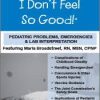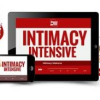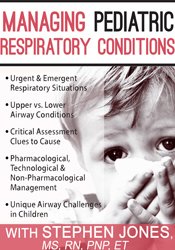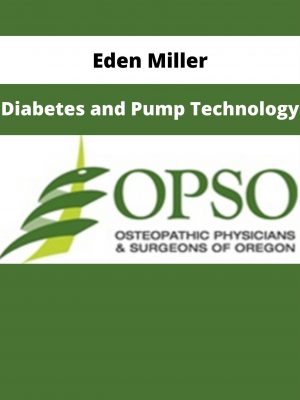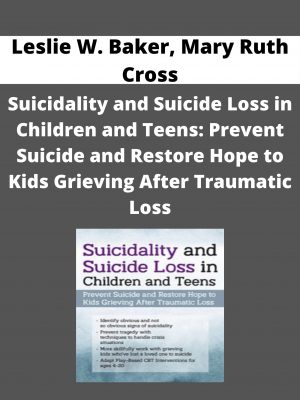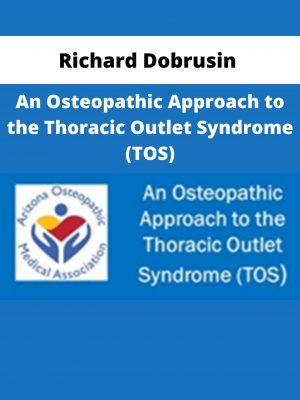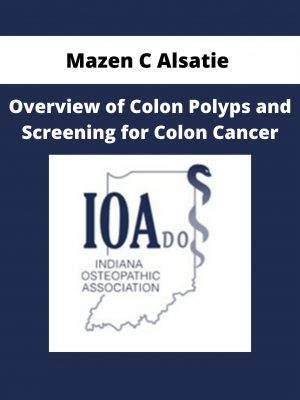Stephen Jones – Managing Pediatric Respiratory Conditions
$219 Original price was: $219.$62Current price is: $62.
Shopping Instructions:
- DISCOUNT 15% : SHOP15
- Product Delivery: Within 1 – 12 hours after purchase.
Children with respiratory conditions may present with acute illnesses, flare-ups of chronic conditions or life-threatening complications.
Stephen Jones – Managing Pediatric Respiratory Conditions
- Urgent & Emergent Respiratory Situations
- Upper vs. Lower Airway Conditions
- Critical Assessment Clues to Cause
- Pharmacological, Technological & Non-Pharmacological Management
- Unique Airway Challenges in Children
I can’t breathe, my chest hurts, I can’t stop coughing… All of these sound familiar?
Children with respiratory conditions may present with acute illnesses, flare-ups of chronic conditions or life-threatening complications. Whether you have experience caring for them every day or find yourself intermittently expected to provide pediatric care, it is imperative to be prepared to identify the condition and intervene appropriately. Stephen Jones, MS, RN, PNP, ET, will provide you with the knowledge you need to manage the numerous respiratory conditions that affect pediatric patients. He will discuss the pharmacological, technological and non-pharmacological management for upper and lower respiratory conditions including critical assessment clues and emergency interventions. Attend this fast-paced, informative and upbeat seminar and you’re guaranteed to leave this day with the skills and knowledge you need to immediately improve outcomes for your pediatric patients.
OUTLINE
Pulmonary Assessment & the “5” Fingered Assessment
- Adventitious Lung Sounds
- Clubbing, Pallor & Cyanosis
- Oxyhemoglobin Dissociation Curve
- Ventilation, Diffusion & Accessory Muscles
- Diagnostics Consideration:
- Pulmonary Function Testing (PFT)
- Airway Clearance: Techniques & Technologies
- The Do’s & Don’ts of Suctioning
- What the Chest X-ray is Telling You
- Lab Values: Normal vs. Baseline
- Determining Critical Clues
Unique Airway Challenges
- Pediatric Patient is not a Small Adult:
- Anatomical and Physiological Differences
- Increased Oxygen Consumption Rates
- The Allergic Cascade
- The Concept of Linked Airways
- Airway Inflammation
- Hygiene Hypothesis
Non-Pharmacological and Technological Management
- Oxygen Therapy
- Devices used for both low and high flow rates
- Pulse Oximetry – What Does It Really Mean?
- Chest X-ray interpretation
- Mist/Humidification
- Medication Delivery Devices
- MDI/Spacer
- Nebulizers
- Dry Powder Inhalers (DPI)
Would you like to receive Stephen Jones – Managing Pediatric Respiratory Conditions ?
Pharmacological Management
- Inhaled
- Antimicrobial
- Anti-Inflammatory
- Anti-Reactive
- Topical
- Antimicrobial
- Anti-Inflammatory
- Anti-Pyretic
- Asthma Medications
- Controller
- Rescue
- Steroids: IV vs. Oral
- Antimicrobials
- Antihistamines: First and Second Generation
- Emergency Medications
Urgent & Emergent Respiratory Conditions
- Tips for Quick Identification
- Critical Interventions for:
- Flail Chest
- Rib Trauma
- Pneumothorax
- Anaphylactic Reaction
- Foreign Body Aspiration
- Status Asthmaticus
Identification & Treatment of Upper Airway Conditions
- Tonsillitis
- Laryngitis/Laryngospasm
- Croup: “The Good, the Bad, the Ugly”
Risk Factors and Treatment Modalities for Lower Airway Conditions
- Pneumonia
- Bronchiolitis
- Interstitial Lung Disease (ILD)
- The 2 Cousins: RSV & Human Metapneumovirus
- Asthma
OBJECTIVES
- Apply the clinical essentials necessary for an efficient and comprehensive respiratory assessment.
- Interpret assessment findings in children with alterations in respiratory status.
- Determine underlying pathophysiology for both upper airway and lower airway conditions.
- Compare and contrast cause versus symptoms of upper versus lower airway conditions when selecting appropriate management strategies.
- Differentiate the management of both urgent and emergent respiratory conditions.
- Discuss non-pharmacological, technological and pharmacological treatment modalities used in managing pediatric respiratory conditions
Related products
HEALTH & MEDICAL
HEALTH & MEDICAL
HEALTH & MEDICAL
Dr Heidi M Crocker – Yoga Alignment | Speaker: Heidi Crocker EdD, DC
HEALTH & MEDICAL
Bernadette Giorgi – Attitude Ballet & Pilates Fusion – Just B Method

